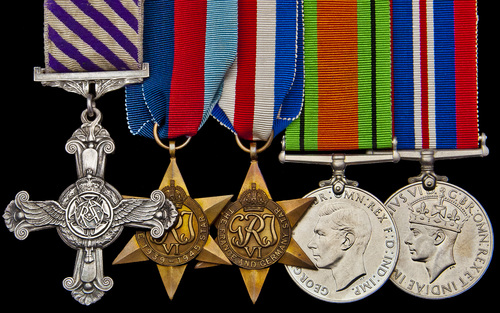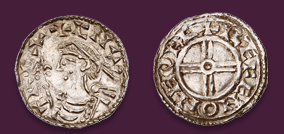
Auction: 15002 - Orders, Decorations, Campaign Medals and Militaria
Lot: 22
A Second War '1944' D.F.C. Group of Five to Halifax and Lancaster Pilot, Flying Officer K. Potts, Royal Air Force Volunteer Reserve, Who Flew in At Least 46 Operational Sorties, With 51 and 35 Squadrons, Before Being Killed in Action En-route to Hannover, 5.1.1945
a) Distinguished Flying Cross, G.VI.R., reverse officially dated '1944', in Royal Mint, case of issue
b) 1939-1945 Star
c) France and Germany Star
d) Defence and War Medals, nearly extremely fine, the Campaign Medals later issues, in named card box of issue with named enclosure slip; bound photocopies of Log Books, several photographic images of recipient in uniform and correspondence from widow (lot)
D.F.C. London Gazette 12.12.1944 Pilot Officer Kenneth Potts (183583), R.A.F.V.R., 51 Sqn
The Recommendation states: 'This officer has completed a successful tour and has proved himself to be a skilful pilot and excellent captain of aircraft. His high standard of leadership, fine fighting spirit and cheerful confidence have won the admiration of all in his Squadron. In September, 1944, during an attack against a target at Venlo, two engines of his aircraft were rendered unserviceable. By skilful airmanship, Pilot Officer Potts flew his aircraft to this country where he executed an emergency landing, thus saving the lives of his crew and avoiding further damage to his aircraft.'
Flying Officer Kenneth Potts, D.F.C., born Southport, Lancashire, 1921; educated at King George V School, Southport and Archbishop Tenisons; employed as a Newspaper Reporter with the South London Press prior to his enlistment in the Royal Air Force Volunteer Reserve, 14.1.1941; carried out initial training at No. 6 E.F.T.S and No. 12 F.T.S.; after postings as an Instructor to No.1 F.I.S., No.2 (P) A.F.U. and No.6 (P) A.F.U. he converted to Wellingtons and Halifaxes; he was posted for operational flying to 51 Squadron (Halifaxes), Snaith, Yorkshire, May 1944; he flew in 39 operational sorties with the Squadron, including: Morsalines; Lens;Hasselt; Trappes; Haringzelles; Herquelingue; 5/6.6.1944, 'Mont Fleury, D-Day Invasion' (Log Book refers); Chateaudon; Alencon; Maisy-Palaiseau; Amiens; Fouillard; St. Martin L'Hortier (2); Siracourt; Oisement (2); Le Grand Rossignol; Marquise; Wizernes; Villers-Bocage - Panzer Divisions; Croixdalle; Le Catelliers; Nucourt; Caen (2); Foret De Nieppe (2); Alderbelck; 3.8.1944, 'Bois De Cassan. S.I. Hit By Flak' (ibid); Hazebrouck; Foret De Mormal; Tirlemont; Kiel; Sterkrade; Brest; Homburg; Lumbres; and 3.9.1944, 'Venlo A/F. Two Port Engines Failed, Hydraulics U/S - Crash Landed' (ibid); his Second Pilot (Flight Sergeant Frew) for the trip to Venlo later recorded, 'Over the target visibility was clear being daylight and there was light anti-aircraft fire. I dropped the stick of bombs, as I recall, onto the runway but was then unable to close the bomb doors. The hydraulics had been hit by the flak so they could not be raised as normal. Neither could we get them up manually, so they hung down causing a considerable drag on the aircraft. This was aggravated by one of the engines also being hit so that had to be feathered. Consequently we started to lose height....
Crossing the North Sea we were very low as by then we had lost the second port engine and it was only due to the magnificent skill of the pilot, Ken Potts, that he managed to keep the aircraft aloft, for there was little power coming from the remaining two engines... As luck would have it it was raining heavily so the ground was soft. The bomb doors, still dangling below in a vertical position, dug into the muddy fields and acted as a brake. On impact the nose of the aircraft broke off and I can recall that, as the lined up wheat sheaves and muddy earth rushed through the opening, I thought later that we had contributed to the English harvest that year!
By the time we had impacted we had managed to feather the remaining engine so the propellers may have helped to retard our forward slide, I presume. The impact of the crash had bent the collapsible set I was sitting on, which had jammed it, so preventing the normal exit for Ken and I out of the rear hatch, but with the nose off, we had no problem walking through the front.'
After converting to Lancasters at N.T.U. Warboys, Potts was posted to 35 (Madras Presidency) Squadron (Lancasters), Pathfinder Force, Graveley, Huntingdonshire, November 1944; promoted Acting Flying Officer, 15.12.1944, he flew in 7 operational sorties with the Squadron, including: Sterkrade; Neuss; Dortmund; Urft Dam; Ludwigshaven; Cologne and Hannover, 5.1.1945; he was killed in action on the latter date when he piloted Lancaster III PB343 TL-M, 'T/O Gravely. Hit by flak and believed to have crashed 1904 between Reide and Thedinghausen' (Royal Air Force Bomber Command Losses of the Second World War, refers); the crew of seven were all killed and Flying Officer Potts is commemorated on the Runnymede Memorial, Surrey.
Potts' D.F.C. was collected from Buckingham Palace by his widow in 1944. In 1951 his widow remarried Sydney Kenneth Coleman (see lot 19). It was not until 2003 that she claimed her first husband's campaign medals.
Subject to 20% VAT on Buyer’s Premium. For more information please view Terms and Conditions for Buyers.
Sold for
£1,400




